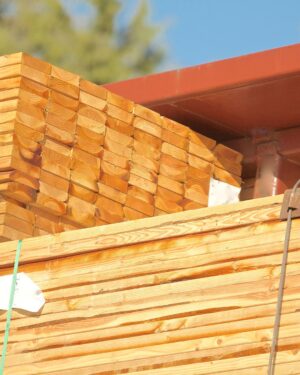The myths of the lumber industry have been around for decades and continue to hold us back from understanding how sustainable this resource really is.
In reality, modern forestry is rooted in responsible practices, renewable resources, and a commitment to the environment.
It’s time to clear the air, bust some common misconceptions, and show how the lumber and wood packaging industries are helping create a greener, more sustainable future for all of us.
These are 5 myths of the lumber industry to stop believing today:
Myth #1: The Lumber Industry Hurts Forest and Soil
This is one of the biggest myths correlated to the lumber industry, but a lot has changed since it originated.
At one point in time, lumber was cut down at an unsustainable rate with no checks in place. But in 1891, the Forest Reserve Act was put into place and eventually became the national forest system that is in place today.
Currently, lumber is harvested in a sustainable way that allows our forests to flourish. In the last 50 years, the volume of American hardwoods has more than doubled because of these practices. The lumber industry has a vested interest in preventing deforestation to keep the supply chain healthy for a sustainable future.
In the United States, lumber companies plant 33% more trees than they harvest each year. They are quite literally growing our sustainable future!
Myth #2: Cutting Down Trees Harms the Environment
This is one of the most common myths about the lumber industry, but it misses the bigger picture.
Responsible logging doesn’t mean clear-cutting forests without thought. In fact, sustainable forestry helps promote healthy growth by removing older trees, preventing disease, and making space for younger, stronger trees.
Many lumber companies also replant trees to maintain a continuous cycle of renewal. When done right, harvesting wood supports forest regeneration and biodiversity.
The key is responsible management, not the elimination of tree use. Using renewable materials like wood can actually reduce reliance on less sustainable alternatives.
Myth #3: Lumber is Not Sustainable
Lumber is a renewable resource, meaning that it can be used without fear of depleting it when using responsible harvesting guidelines.
Renewable resources are virtually inexhaustible and can replenish themselves over time. When properly managed, they are sustainable, abundant, and replenishable.
Wood’s carbon-capturing abilities make it a net positive carbon emission resource. This means that the trees will absorb more carbon dioxide in their lifetime than it takes to harvest, process, and manufacture them into products.
Younger forests capture even more carbon dioxide than older forests, so replanting strategically has a positive environmental impact.

Myth #4: The Wood Industry Consumes Resources Without Replenishment
As stated in the previous myths, the lumber industry wants to keep forests growing and thriving for a sustainable future.
With the federal guidelines in place, lumber is harvested and sold responsibly for the vast majority. There are over 5 million trees planted each day in the United States!
If you want to do your part, look for a reliable lumber supplier that adheres to the FSC (Forest Stewardship Council) policies.
Myth #5: Wood is Not an Environmentally-Friendly Manufacturing Material
The wood packaging industry uses a lot of lumber to keep production lines and products moving all across the country.
Wood packaging, such as pallets and crates, are an essential part of every manufacturing industry. This type of packaging is way more sustainable than the plastics and metals that are used in manufacturing.
If it is not recycled completely, wood will spend much less time in the landfill because it is biodegradable. Wooden materials are sustainable and have less negative impact than other commonly used materials.
For the wood packaging part of the lumber industry, sustainable packaging means creating a more sustainable future.
Conner’s Commitment
Conner Industries has a commitment to using sustainability policies, principles, and goals to create a sustainable future within our company and the industry as a whole. We have the goal of reaching a 30% reduction in energy usage by 2030 and improving fiber utilization by 30% within the next ten years.
As a leader within this industry, we want to lead the way in making strides towards greener processes.
The Truth About Lumber
The myths of the lumber industry don’t tell the full story.
With sustainable practices, smart resource management, and a focus on renewal, the industry is far greener than most people realize. It’s time to move past the myths and see the real impact of modern lumber and wood packaging practices.






